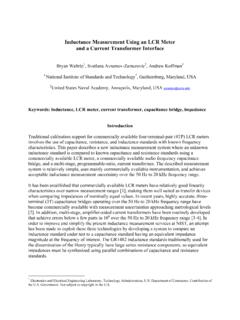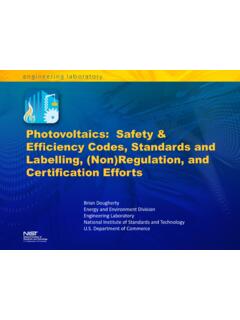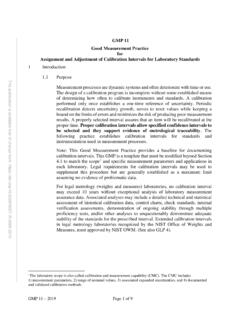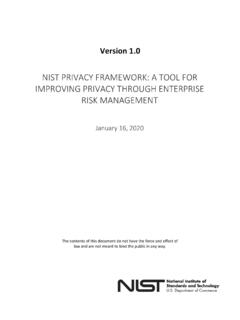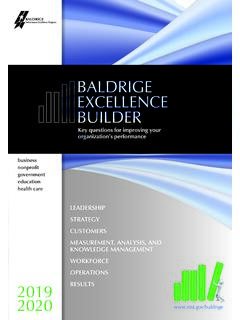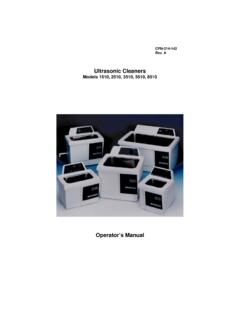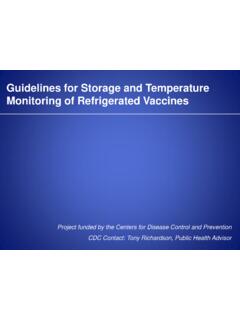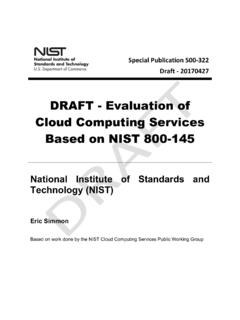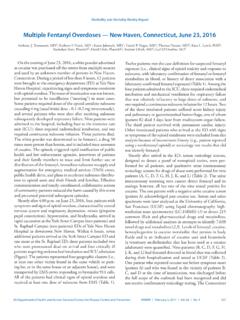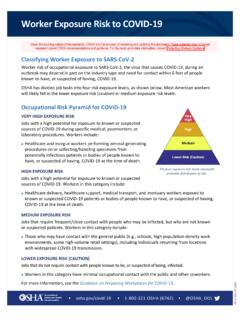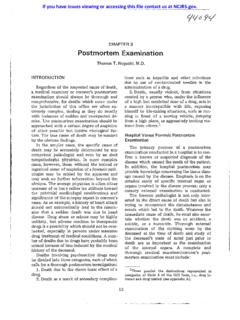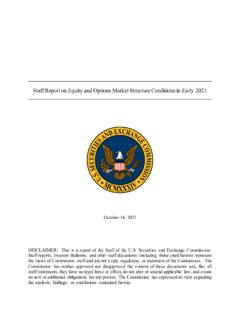Transcription of Trauma Analysis - NIST
1 Page 1 of 7 Scientific Working Group for Forensic Anthropology (SWGANTH) Trauma Analysis Issue Date: 05/27/2011 Revision: 0 Trauma Analysis Principle, Spirit and Intent Skeletal remains should be analyzed in a systematic manner for the purpose of determining both timing and mechanism of skeletal ( osseous and dental) Trauma that may be relevant to the circumstances of death or other pertinent forensic questions. Analysis of Trauma should involve careful observation and thorough documentation, and interpretations should be based on scientifically valid methods and principles. Purpose and Scope The following guidelines outline procedures for describing, documenting and interpreting skeletal Trauma .
2 These guidelines apply to all practitioners of forensic anthropology and should be implemented to the fullest extent practical and appropriate. In the absence of specific procedures or in the case of conflicting procedures, the principle, spirit and intent should be met. General Principles Forensic anthropologists may contribute to Trauma Analysis through assessment of: (1) the timing of the Trauma ( , antemortem, postmortem or perimortem), and (2) the mechanism that produced the Trauma ( , projectile, blunt, sharp, thermal). The Analysis of Trauma requires the application of elements of physics, biomechanics, materials engineering, ballistics, taphonomy, anatomy and osteology.
3 Even still, a definitive conclusion may not be forthcoming and equivocal results should be reported as such. With the exception of cartilage, which may be examined for Trauma by the anthropologist, soft tissue examination is typically the purview of the pathologist. Documentation should include descriptive text, photographs, diagrams and radiographs. Descriptions should include the location and characteristics of Trauma using measurements and standard anatomical terms. When assessing skeletal Trauma , remains should be examined before and after processing, and clothing damage relative to skeletal alterations should be considered when possible. Page 2 of 7 Careful consideration should be given when estimating the post-injury interval.
4 A distinction must be drawn between description and interpretation. A description is essential to any report of Trauma , but it is important to reserve an interpretation for cases where observations supporting a specific conclusion can be enumerated. Best Practices Trauma Timing Characteristics and morphology of the alteration are used to assess when the Trauma occurred relative to the death of the individual. Trauma timing may be classified as antemortem or perimortem. postmortem alterations to bone are considered taphonomic events rather than Trauma but will be addressed in these guidelines. To classify Trauma timing, the alteration should be examined visually.
5 Examination may also include the use of a low magnification microscope and/or radiography. When a distinction cannot be made between antemortem, postmortem and perimortem, this should be clearly stated. Antemortem Trauma Antemortem Trauma refers to an alteration produced before an individual s death that displays evidence of osteogenic reaction. Features that may indicate antemortem Trauma include: Evidence of healing or healed fractures Development of a pseudarthrosis Trauma -induced degenerative joint disease Infectious response Dental fractures with worn edges Surgically implanted devices When Trauma is classified as antemortem, consideration should be given to.
6 Fracture type ( , simple, spiral) and the degree of healing to the fractured edges/margins The age of (time since) the Trauma , which may affect the ability to identify the mechanism of Trauma Biological factors such as age, sex, pathology and nutrition, which may affect healing rate Whether the Trauma may present evidence for identification and cause and/or manner of death Whether re-injury may have occurred, interrupting the healing process Page 3 of 7 Perimortem Trauma Perimortem Trauma refers to an injury occurring at or around the time of death. Because of the properties of bone, the timing of injury is less precise when evaluating bone than when evaluating soft tissue.
7 Within the anthropological realm, perimortem is determined on the basis of evidence of the biomechanical fracture characteristics of fresh bone. Perimortem Trauma is a category in which remains lack evidence of healing and lack diagnostic taphonomic evidence of postmortem damage. Features that may indicate perimortem Trauma include: A lack of osteological activity such as healing or infectious response The presence of fresh bone fracture characteristics ( , plastic response) The absence of dry bone fracture characteristics ( , angular fractures) An overall fracture pattern characteristic of a terminal event ( , rapid deceleration event) When Trauma is classified as perimortem, consideration should be given to: Cautious use of the term perimortem, since it is used with varied temporal precisions within the forensic community.
8 Thus, an explanation of the term should be provided with clear reasons for a perimortem classification The inability to distinguish between antemortem, perimortem and postmortem damage should be clearly stated Classification of Trauma as perimortem is strengthened when the mechanism can be identified Other indicators that may establish Trauma as perimortem ( , hair entrapped in bone with associated blunt Trauma injuries, the presence of blood staining) postmortem Damage postmortem damage refers to taphonomic alteration or defects produced after an individual s death that are unassociated with the death event. Features that may indicate postmortem damage include: Differentially stained or recently exposed surfaces A lack of healing Characteristics of the break lacking evidence of a plastic component.
9 Pattern of damage When alterations are classified as postmortem damage, consideration should be given to: Terminology used to describe the alteration - terms such as damage or breakage are preferred when describing postmortem incidents; the term fracture should be reserved for viable bone Possible confusion with perimortem Trauma Page 4 of 7 Trauma Mechanism Trauma mechanism refers to the force(s) that produce skeletal alterations and may be classified as resulting from high-velocity projectile, sharp force, blunt force or thermal exposure. Assessment of Trauma mechanism is dependent on pattern recognition as well as the contributions of intrinsic and extrinsic factors that dictate the way bone fractures.
10 To classify Trauma mechanism, the alteration should be examined visually and, when possible, before processing occurs. Examination may also include the use of a low magnification microscope and/or radiography. Reconstruction of fractured bones should be done to clearly establish the Trauma mechanism unless circumstances do not permit reconstruction. Fracture margins and the angle of fracture surfaces can be important in interpretation and should be examined before reconstruction. Observed patterns should be compared to literature or other reference material to aid in classification of mechanism. Sequence multiple wounds only when there are clear indications of the order.
